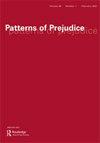The long life of British fascism
IF 0.8
2区 社会学
Q4 ETHNIC STUDIES
引用次数: 0
Abstract
Historian Joe Mulhall’s British Fascism after the Holocaust: From the Birth of Denial to the Notting Hill Riots, 1939–1958 begins with a celebration. The relief and jubilation are almost palpable in the British newspapers that marked the end of the Second World War. Headlines described Britain as the nation that ‘stood alone’ against fascism and confidently proclaimed ‘fascism had had its day in England. There could be no “come back”’ (1). But, just as quickly as Mulhall introduces the celebratory articles, he dispels such mythology. British Fascism after the Holocaust traces British fascists’ political activities during and after the war. Linking interwar and war-time fascist ideology with post-war groups challenges the cherished national discourse about Britain as a beacon of anti-fascist activism. Mulhall demonstrates that fascists were not only present in the post-war political landscape, they were relentlessly active. The individuals and organizations that re-articulated fascist ideology in post-war Britain became the genesis of both Holocaust denial and anti-immigrant sentiment in the country. Indeed, he argues, it is impossible to understand the later electoral gains of fascist parties like the 1970s-era National Front without charting the ideological continuities between interwar fascism and post-war fascist ideology. Mulhall’s book joins an extensive body of scholarship on British fascism and its place in the nation’s political landscape. His intervention is particularly salient for fascist ‘origins studies’ where scholars have rightly questioned whether similarities in fascist ideology across historical periods ‘necessarily amount to the same thing’. British Fascism after the Holocaust suggests that a high degree of transference between ‘periods’ of fascism means it is impossible to wholly separate one iteration of fascism from another. Instead, he charts ‘an unbroken thread’ that persists through wildly different interwar and post-war political climates (2). Divided into seven chapters, British Fascism after the Holocaust provides readers with a number of important interventions. Its early chapters chart英国法西斯主义的漫长生命
历史学家乔·穆霍尔(Joe Mulhall)的《大屠杀后的英国法西斯主义:从否认的诞生到1939年至1958年诺丁山暴乱》以庆祝活动开始。在标志着第二次世界大战结束的英国报纸上,这种宽慰和欢呼几乎是显而易见的。头条新闻将英国描述为一个“独立”反对法西斯主义的国家,并自信地宣称“法西斯主义在英国已经有了辉煌的一天”。不可能有“回来”(1)。但是,正如穆霍尔介绍庆祝文章一样,他很快就消除了这种神话。大屠杀后的英国法西斯主义追溯了英国法西斯在战争期间和战后的政治活动。将两次世界大战和战争时期的法西斯意识形态与战后团体联系起来,挑战了人们珍视的关于英国是反法西斯激进主义灯塔的国家话语。穆霍尔证明,法西斯主义者不仅存在于战后的政治格局中,而且他们坚持不懈地活跃着。战后英国重新阐述法西斯意识形态的个人和组织成为该国否认大屠杀和反移民情绪的根源。事实上,他认为,如果不描绘两次大战之间法西斯主义和战后法西斯主义意识形态之间的意识形态连续性,就不可能理解像20世纪70年代的国民阵线这样的法西斯政党后来的选举成果。穆霍尔的书加入了大量关于英国法西斯主义及其在国家政治格局中的地位的学术研究。他的干预在法西斯“起源研究”中尤为突出,学者们正确地质疑历史时期法西斯意识形态的相似性是否“必然是同一件事”。大屠杀后的英国法西斯主义表明,法西斯主义“时期”之间的高度转移意味着不可能将法西斯主义的一次迭代与另一次迭代完全分离。相反,他描绘了一条“不间断的线”,这条线在两次世界大战和战后截然不同的政治气候中持续存在(2)。《大屠杀后的英国法西斯主义》分为七章,为读者提供了一些重要的干预。其早期章节图表
本文章由计算机程序翻译,如有差异,请以英文原文为准。
求助全文
约1分钟内获得全文
求助全文
来源期刊

Patterns of Prejudice
Multiple-
CiteScore
2.50
自引率
0.00%
发文量
11
期刊介绍:
Patterns of Prejudice provides a forum for exploring the historical roots and contemporary varieties of social exclusion and the demonization or stigmatisation of the Other. It probes the language and construction of "race", nation, colour, and ethnicity, as well as the linkages between these categories. It encourages discussion of issues at the top of the public policy agenda, such as asylum, immigration, hate crimes and citizenship. As none of these issues are confined to any one region, Patterns of Prejudice maintains a global optic, at the same time as scrutinizing intensely the history and development of intolerance and chauvinism in the United States and Europe, both East and West.
 求助内容:
求助内容: 应助结果提醒方式:
应助结果提醒方式:


